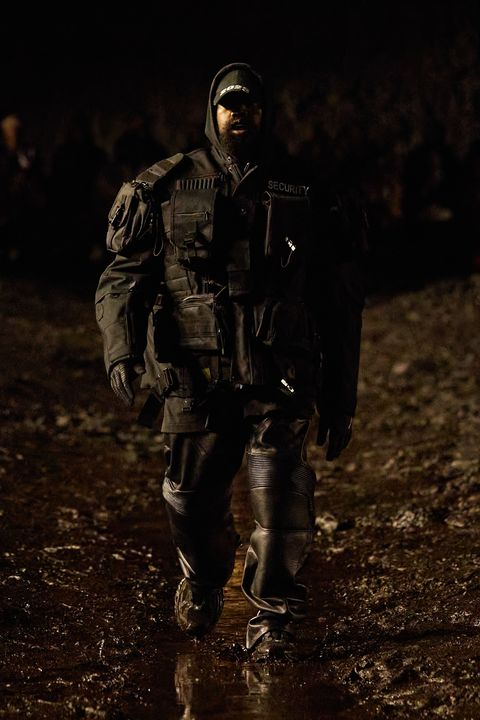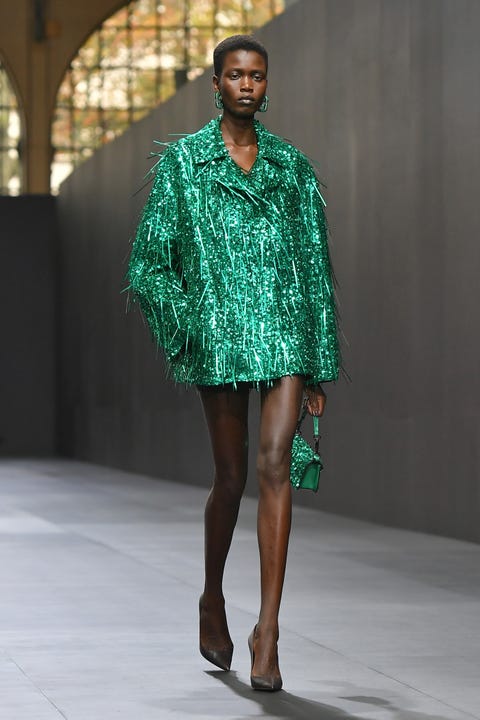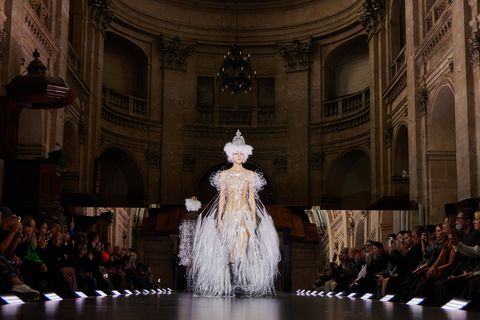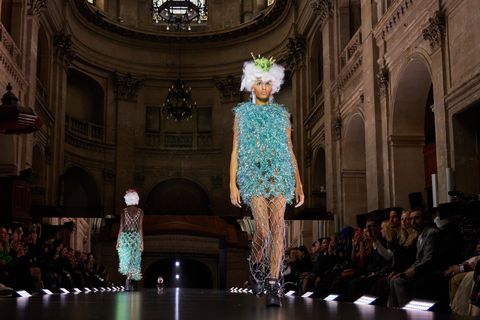This past weekend in Paris, the shows were all about boxes. Who’s feeling boxed in (Balenciaga’s Demna), who’s breaking out (Valentino’s Pierpaolo Piccioli), and who’s blissfully never heard of a box that could contain them (Rei Kawakubo, of Comme des Garçons, and Kei Ninomiya, who designs under the name Noir Kei Ninomiya).
A feeling that creativity needs to be elevated and respected was already percolating this fashion month. The Prada show, anyway, was about refusing telegraphic and concise runway show messages, and instead seeing fashion as an invitation to conversation and thought. Jonathan Anderson, at both Loewe and JW Anderson, was obsessed with challenging himself and his team to think more strangely. Even the sense of whimsy at The Row and Rick Owens made playfulness seem like a larger social statement.
A conversation about creativity, ambiguity, and intellectual delight is beginning across culture, I think. How does an artist or creator make something that feels not just new, but more interesting and challenging? (I don’t mean socially challenging, as in provocative, but rather something engaging enough to make you pause and consider multiple readings.) Maybe the intention of making everybody feel the same obvious thing is fading amid a pursuit of exploration and curiosity. This feels especially urgent in fashion, where the demand for newness is overwhelming and almost all conversations for and against it feel trite.
But Demna was the first to make these questions the center of his collection, by bringing us right down into the mud to look at his little shortie sweat suits and knotted jersey gowns and young dads striding ahead with AirPods in their ears and a kid in the Balenciaga baby carrier. (Don’t worry: The babies were fake.) The set was a starkly lit expanse of mud, piled up behind us and dug into a pit below, created by the Spanish artist Santiago Sierra and echoing a piece he created in 2003. We were there to get down in the mud with Demna.
“Fashion loves boxes and labels more than anything,” Demna wrote in a note placed on each of our seats. “Putting luxury fashion into the box of polished, exclusive, and visually expensive is limited and pretty old school. Individualism in fashion is downgraded to pseudotrends dictated by a post in stories of some celebrity of the moment.” (It’s notable that a designer at this level is so aware of how fashion is discussed online.)
You might wonder how the designer of one of the world’s most successful fashion houses feels boxed in. Balenciaga is one of Kering’s star brands; Demna is one of the conglomerate’s big-shot designers and is especially beloved by fashion fans for the couture collections he started showing annually in the summer of 2021. Even the fact that he launched couture, which the house hadn’t produced since Cristóbal Balenciaga himself was designing there more than 50 years ago, suggests that this is a man understood enough by his bosses and peers to get whatever he wants.
Still, I do think there’s a lot that is misunderstood about Demna. People have written him off online as a cynic and a fashion huckster who “tricks” consumers. This collection was filled with Demna classics, like a pointier-toed version of his rubber Croc-like clogs, oversized leather jackets, bags with sleeves, plisse cape gowns, and blousy jeans and trousers worn over Balenciaga logo boxers and styled with Internet meta-commentary T-shirts. At the end, there were some spectacular floating sequined knit gowns that with their grit and earthiness would never show up in his couture shows, at least to my mind. And just minutes after the show, I saw people writing these clothes off on my Twitter feed.
But what’s clear from any conversation with Demna (or even spending a bit of time rolling around in the mud of his glorious ambiguity) is that he loves fashion. He makes these meme-like pieces, like Lay’s potato chip handbags (a wink at footage that circulated this past summer of the designer carrying around a bag of chips as an accessory) and a heart-stopping finale gown of patched-together Motorcycle bags, because he believes in them. And obviously, customers believe in them, too: Balenciaga is one of the few brands I see people outside the fashion world wearing head to toe all over New York City (and this week in Paris, just wandering the streets). What some observers seem to read as menace or anger seems to make a lot of people feel extraordinarily happy and free. It makes them feel, you know, seen. Just look at Ye opening the show in a blown-up video game hero look: He walked like he was turbocharged, and he looked quite joyful.
Demna has completely changed fashion over the past decade. His reach is such that things that have nothing to do with fashion—sweatshirts and brand logos and bags of chips—now look like fashion, which is to say they look like a choice the wearer has made about how to express an identity in this stupid world. He has earned the right to do whatever the heck he wants. Instead of looking at this collection and seeing a bag of tricks, I see a creative director enjoying himself producing the kinds of pieces that he called in a backstage interview “the real me.” I see a tender human relieved that after a tumultuous early life as a queer man in war-torn Georgia, he can finally express himself as he chooses. “Fashion in its best case scenario should not need a story to be sold to someone,” Demna wrote. “You either like it or not.” In other words: The girls who get it, get it, and the girls who don’t should move on!
A few hours later, Pierpaolo Piccioli staged a Valentino show that pushed against the confines of a different box. The audience was filled with attendees dressed in the Valentino hot pink he introduced last season, and a bold, if puzzling, mission statement was provided: “Pureness as a conscious synthesis, the intentional removal of what exceeds. It is subtraction, not absence. The creative process keeps track of what was taken away. It leads to the essential, with all the tension of implication.” The idea is that this emptiness would “declare personal choices. In those commissions, in those allusions, lays the depth of identity.” Okay, so, if you take every detail away, what emerges is the person. I can roll with that!
In fact, the statement made the show’s shortcomings all the more painful. Most uncomfortably, his models (almost all first-timers, though that isn’t an excuse) were struggling to walk in their stilettos and platforms. I saw a few models sweating at the turns of the runway and others with tears in their eyes, and witnessed two girls trip. I wondered, too, about the choices to dress the models in flesh-tone garments and tattoo their skin with the Valentino logo, both of which are fashion choices that set off alarms in millennial and Zoomer brains for their potential to read as equating identity with trendiness, or implying that there is no difference between race or gender expression and a feathered blazer. I’m not saying you can’t go there—Marine Serre, Jean Paul Gaultier, and Shayne Oliver have all done it—but it takes a very gentle touch.
Piccioli has the soul of a romantic and an artist; his pink statement last year was a moving visual declaration of how individuality emerges when an offering of beauty, like a color and the magic of savoir faire, is distributed to everyone. And I think he really loves women. This show, though, felt out of character in its concept and execution.
Obfuscation was the point at some of Saturday’s best shows. This was the Comme des Garçons comeback season: The stable of brands, which includes Rei Kawakubo’s line, as well as Junya Watanabe and Kei Ninomiya, was showing in Paris for the first time since before the pandemic. They did not disappoint, perhaps because the standards are so high and yet so naturally achieved. One gets the sense that most of the design conversations, especially for Kawakubo and Ninomiya, are about making things bigger, more beautiful, and more unusual. Ninomiya has mastered the lovely in-between of machine and nature; the materials he used to make the dresses he showed Saturday could have been human hair or some funky new plastic.
And challenging the world is just what Kawakubo does. The designer offered a brief message of fear and hope in the show notes. Though she has been making these fabric sculptures that almost transcend clothing since about 2015, she has used the forms to create a multitude of statements. Sometimes the pieces look uncomfortable, like an albatross around the model’s neck; sometimes they look like a practical joke on the wearer; sometimes they just look extremely gorgeous. Here, I saw the puerile trimmings of glamour and femininity, like sequins, ruffles, lace, and even a miniskirt in the opening look, which gave a sense of optimism about the world that the designer seemed to embrace as naive. But one look was like a floral black hole of fabric—a note of surrender amid all the good cheer.
Rachel Tashjian is the Fashion News Director at Harper’s Bazaar, working across print and digital platforms. Previously, she was GQ’s first fashion critic, and worked as deputy editor of GARAGE and as a writer at Vanity Fair. She has written for publications including Bookforum and Artforum, and is the creator of the invitation-only newsletter Opulent Tips.
Let Demna Do Whatever He Wants
Newspaper Updates PH





0 comentários :
Post a Comment